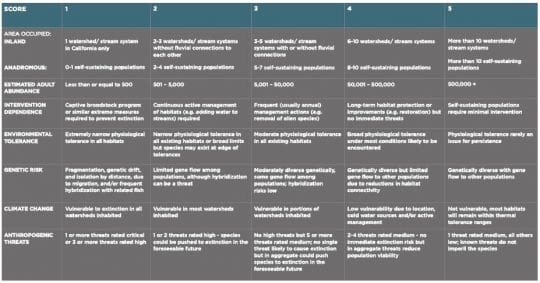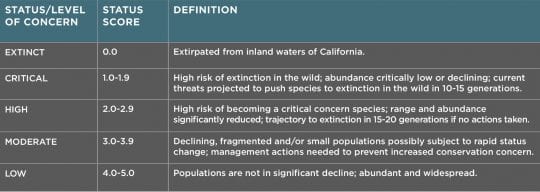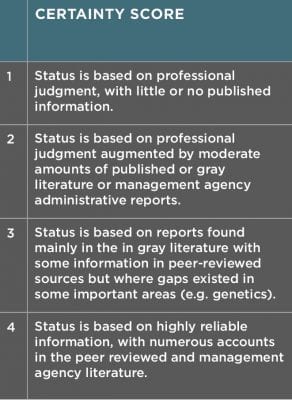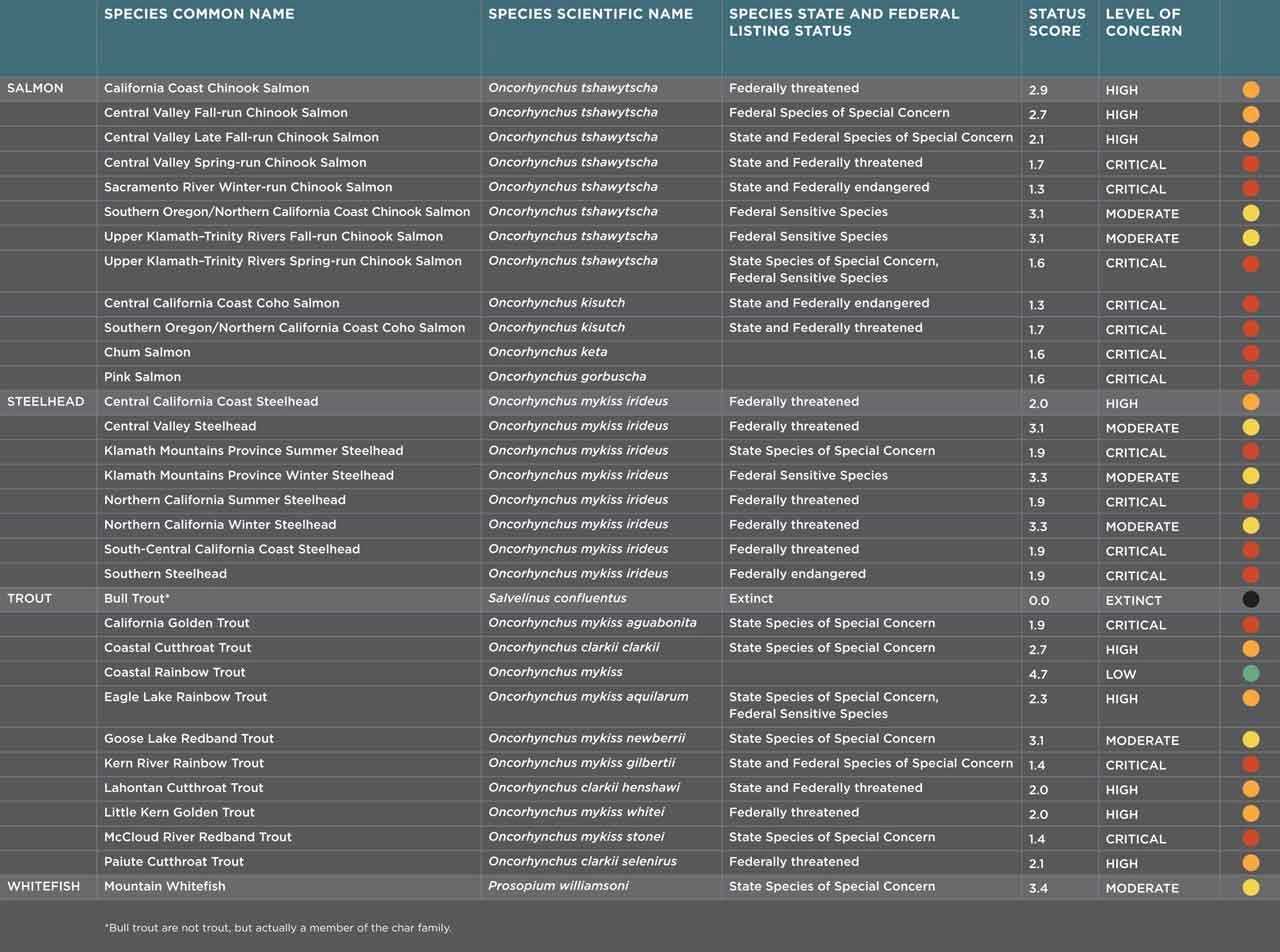SPECIES STATUS ASSESSMENT
For the State of the Salmonids II: Fish in Hot Water report, the following methods were used to assess the status of all 32 kinds of salmon, steelhead, and trout in California.
SELECTION OF SPECIES
The research team used species, subspecies, Evolutionary Significant Units (ESUs), or Distinct Population Segments (DPSs) - taxonomic categories already recognized by state and federal natural resource agencies for management as “species.”
The research team also recognized a few distinct life history variants of Chinook salmon and steelhead (e.g., summer steelhead) that are not yet recognized as distinct entities by all management agencies. They nonetheless possess, in our judgment, sufficient significant evolutionary, ecological, and genetic differences to merit being treated as distinct taxa. This report focuses solely on native California salmonids. It does not include introduced species: Brown trout, Brook trout, Lake trout, Kokanee salmon, or Colorado Cutthroat trout. Dr. Peter Moyle’s laboratory group at UC Davis has been continuously evaluating California’s fish fauna since the first edition of Inland Fishes of California (1976) and the first edition of Fish Species of Special Concern in California (1989). The language has evolved and expanded as research has become available, and this report represents the evolution of those assessments to provide snapshots in time of species status under current trends.
LITERATURE COMPILATION
The research team conducted a literature review to: (1) update information for each taxon; (2) analyze detailed summaries for taxa not adequately treated in previous reviews; and (3) find ‘gray’ literature such as agency administrative reports not used in previous accounts. The team also consulted with over sixty individuals and experts from fishery management agencies familiar with each taxon to obtain unpublished and anecdotal information and gain a better understanding of local conditions.
PRODUCTION OF SPECIES ACCOUNTS
The full, peer-reviewed species accounts, or “main accounts,” are literature reviews with extensive documentation and will be published as Salmon, Steelhead, and Trout in California: Status of Emblematic Fishes, Second Edition.
From these accounts, the research team produced condensed accounts that are presented in this report. These condensed accounts necessarily leave out many important details found in the main accounts, and readers should consult the main accounts as the basis for the information where questions arise. Each main account was drafted using a standard format, with sections for species description, taxonomic relationships, life history, habitat, abundance, threats, climate change, status scoring analysis, and conservation recommendations.
All drafts were reviewed and revised by the research team until they were satisfied with the accuracy of the drafts and then underwent a final review by at least one, but in many cases more than one, external biologist familiar with the taxon and its status.
EVALUATION OF STATUS
 The status of each species was evaluated using a set of seven criteria scored using the rubric above (click to enlarge). Those scores were then averaged to produce an overall score for each species - the Level of Concern (see table below). A reliability index was provided for each account based on the certainty of available information (see table below).
The status of each species was evaluated using a set of seven criteria scored using the rubric above (click to enlarge). Those scores were then averaged to produce an overall score for each species - the Level of Concern (see table below). A reliability index was provided for each account based on the certainty of available information (see table below).
OVERALL ANALYSIS
The team summarized the status rankings for all 32 taxa and for each of the seven criteria and compared the Level of Concern of all taxa to those found in the first edition of the State of theSalmonids report to determine trends in status. The comparisons were made using verbal assessments based on the accounts and status scores, rather than comparing the status scores from the two accounts directly. Numerical status scores were not directly compared between years due to: (1) greatly improved metrics for species distribution and abundance; (2) an improved metric for climate change, based on a study by Moyle et al. (2013); and (3) addition of a new metric that quantified anthropogenic effects (below). We decided the two scoring systems were different enough that the scores should not be directly compared, so we instead used the assessment categories from the 2008 report: extinct, critical concern, high concern, moderate concern, and low concern.

GLOSSARY
ADFLUVIAL life history in which juvenile fish are born in streams, migrate to lakes to feed and grow, and then migrate back to natal streams as adults to spawn
ADIPOSE FIN a small, fleshy fin on the back of salmonids near the tail that is sometimes clipped off salmon and steelhead to allow easy differentiation from wild fish for management purposes
ALEVIN A newly hatched salmonid that is still carrying the yolk sac Amphipods a group of crustaceans without a carapace, or exoskeleton Anadromous fish that are hatched in fresh water, migrate to and mature in salt water, and return to fresh water to spawn
ANTHROPOGENIC human-induced or exacerbated, as in climate change Barrier a manmade structure such as a dam or culvert which prevents fish passage in a stream
BENTHIC occurring at the bottom of a body of water, such as a river or lake
BROODSTOCK a group of sexually mature individuals of a cultured species that is kept separate for breeding purposes, such as to support hatchery operations
CALIFORNIA CURRENT a Pacific Ocean current that moves south along the western coast of North America, beginning off southern British Columbia, and ending off southern Baja California
CENTRAL VALLEY a large, flat valley that dominates the central portion of California; the northern half is referred to the Sacramento Valley and its southern half as the San Joaquin Valley
CLIMATE CHANGE refers to the human-induced increase in the average temperature of the Earth’s near-surface air and oceans and changes in its precipitation and wind patterns
COBBLE naturally rounded rock fragments between 2 1/2 inches and 10 inches in diameter
CODED WIRE TAG a small magnetized wire injected into the snout of juvenile fish to track their migrations to support research and management
CONJUNCTIVE USE the practice of storing water on the surface of the Earth in groundwater basins in wet years, and then withdrawing it for use during dry years
COPEPOD a group of small crustaceans that inhabit most fresh water habitats and oceans
CRITICAL HABITAT a specific geographic area, whether occupied by a special-status species or not, that is determined to be essential for the conservation and management of special status species
CRUSTACEANS animals, including crabs, shrimp and crayfish that have a hard shell instead of a skeleton and that usually live in water
CALIFORNIA DEPARTMENT OF FISH AND WILDLIFE (CDFW) the California state agency tasked with managing California’s diverse fish, wildlife, and plant resources, and the habitats upon which they depend, for their ecological values and for their use and enjoyment by the public
DISSOLVED OXYGEN oxygen freely available in water and necessary for the lives of fish and other aquatic organisms
DISTINCT POPULATION SEGMENT (DPS) a term with specific meaning under the Endangered Species Act when used for listing, delisting, and reclassification purposes to describe a population that may be added or deleted from the list of threatened and endangered species; applied here to steelhead
DRAINAGE a group of interconnected streams whose main channel enters an ocean, estuary, or the main- stem of a basin
ECOSYSTEM a recognizable unit on the landscape that includes organisms, their environment, and all the interactions among them
EFFECTIVE POPULATION SIZE the average number of individuals in a population that contribute genes to the succeeding generations
ENDANGERED SPECIES under the Endangered Species Act, any species that is likely to become extinct within the foreseeable future throughout all or a significant portion of its range
ENDANGERED SPECIES ACT (ESA) the federal Endangered Species Act that was enacted by Congress in 1973 in response to an alarming decline of many animal and plant species. The ultimate goal of the Act is to return threatened and endangered species to the point where they no longer need the law’s protections
ENDEMIC SPECIES a species native and confined to a certain region; usually with a comparatively restricted distribution
ESTUARY/ESTUARINE the area or habitat where fresh and salt water mix at the mouth of a river, used as rearing and feeding habitat by many fish species and other animals
ENTRAINMENT the incidental trapping of fish and other aquatic organisms in water diverted from streams, rivers and reservoirs; the process of drawing fish into diversions, along with water, resulting in the loss of such fish
ESCAPEMENT those fish that survive natural mortality and harvest, and make up a spawning population
EVOLUTIONARY SIGNIFICANT UNIT (ESU) a term used by the National Marine Fisheries Service to denote a population or group of populations of salmon that is substantially reproductively isolated from other populations and contributes to the evolution of the species
EXTANT still in existence or surviving
EXTIRPATED a species that has been eliminated from a particular area, but still exists elsewhere; locally extinct
EXTINCT a species that no longer exists in any habitat on Earth
EXPERT JUDGMENT based on the professional opinions of experts; used here as biologists best guesses
FAUNA all of the animal life of any particular region or time
FISHERY specific species of fish, area of water or seabed, fishing method, class of boats, people involved in catching or processing fish, or a combination of these
FLOODPLAIN the low area along a stream or river channel into which water spreads during floods; can be valuable feeding habitat for salmonids and provide refuge from high flows
FLUVIAL a life history in which fish are born in rivers or streams and spend their entire lives there
FORBEARANCE refraining from exercising a legal water right; used to keep water in streams on a temporary basis without permanently giving up the right to that water
FRY a stage of development in young salmon or trout; during this stage the fish is usually less thanone year old, has absorbed its yolk sac, is rearing in the stream, and is between the alevin and parr stageof development
GENETIC DIVERSITY the total number of genetic characteristics in the makeup of a species that allow populations to adapt to changing environmental conditions
GENETIC RISK the probability of an action or inaction having a negative impact on the genetic character of a population or species
GILL covers the outer covering of the gill chamber which opens and closes to allow water to pass over the gills for respiration
GRAY LITERATURE refers to material that is not formally published, such as institutional or technical reports, working papers, business documents, and conference materials
GRILSE a salmon that has spent only one winter at sea before returning to fresh water to spawn
HABITAT the physical, chemical, and biological features of an area that supplies food, water, shelter and space necessary for a particular species’ existence
HALF-POUNDER an immature steelhead that spends only a few months at sea, enters fresh water in spring, feeds until the following winter, then migrates to sea again before returning to spawn
HEADWATERS the source or upper part of a lake, river, or stream
HOMOGENOUS all alike, as in a loss of genetic diversity leads to homogenized populations
HYBRIDIZE/HYBRIDIZATION to breed plants or animals of different varieties or species in order to create offspring having characteristics of each; here used to highlight breeding of related but distinct species
HYDROLOGY the movement of water across the landscape, including the water cycle
INTROGRESSION the spread of genes from one population or species into another as a result of hybridization
INVERTEBRATE an animal without a backbone, many of which serves as prey for salmonids
ITEROPAROUS reproducing more than once in a lifetime Juvenile fish from one year of age until sexual maturity
KELT a salmonid that has spawned but not yet returned to sea Kype the distinctive hooked jaw that male salmonids develop during spawning
LACUSTRINE a life history where fish spend their entire lives in lakes
LIFE HISTORY a series of changes an organism undergoes during its lifetime, or the timing of key events in an organisms’ lifetime, such as sexual maturation and behavior
NATAL STREAM stream of birth, where a fish hatches
NATIVE SPECIES an indigenous stock of fish that has not been substantially affected by genetic interactions with non-native stocks or by other factors and is still present in all or part of its original range
NET PEN a mesh enclosure used to confine juvenile salmon and allow them to acclimate to brackish or salt water before release
NATIONAL MARINE FISHERIES SERVICE (NMFS) a federal agency and division of the Department of Commerce, responsible for the stewardship of the nation’s living marine resources and their habitat
PARR the stage in sea-going trout and salmon prior to the smolt stage and migration to salt water
PARR MARKS distinctive vertical, dark oval markings on the sides of young salmon or trout
PEER REVIEWED LITERATURE scientific writing or research that has undergone evaluation by other experts in the field to judge if it merits publication or funding
PIKEMINNOW (Ptychocheilus spp.) a torpedo-shaped fish with an olive-green and gold back, white belly, and black stripe on its side; a major natural predator on juvenile salmonids in California
PISCICIDE a chemical substance which is poisonous to fishes
POOL a relatively deep, still section in a stream
REACH a section of stream defined in a variety of ways such as the section between tributaries or a section with consistent characteristics
REAR to bring to maturity
REDD a circular or oval-shaped depression excavated by adult female salmonids with their tails where eggs are laid
REINTRODUCTION putting a species back into a former habitat Resident describes species of fish which spend their entire lives in fresh water
RESILIENCE the ability of ecosystem or species to withstand ecological disturbance while maintaining its normal patterns of operation and function
RESTORATION/CONSERVATION HATCHERY a hatchery designed to produce fish for restoration purposes rather than for recreational purposes
RICHNESS the number of different species represented in an ecosystem
RIPARIAN HABITAT the terrestrial habitat adjacent to streams, lakes, estuaries or other waterways
RIVERINE situated on or in a river or its banks
ROTENONE a plant-based, odorless, colorless, piscicide commonly used for removing fish from a stream
RUN the time at which a fish swims back up the rivers in which they were born to spawn
SALMONID any member of the taxonomic family Salmonidae, which includes all species of salmon, trout, char, whitefish and grayling
SEDIMENTATION fragmentary material that originates from the weathering of rocks or the additions of materials from manmade activities into a river
SMOLT the third stage in the development of a trout, salmon or char, when the small, silvery fish have undergone physical changes to allow them to begin their migration from fresh water to the sea
SPAWN the release and fertilization of eggs
SPAWNING RUN the migration of fish to the place where they mate and lay their eggs
STEELHEAD a form of Rainbow trout that migrates from the stream in which it was born to the sea and back to its home stream to spawn
STRAYING the behavior of fish to migrate or return to non-natal streams for various purposes such as feeding, exploration, or spawning
STRONGHOLD a place that provides sufficient habitat quantity and quality to serve as a refuge for a species
TAXONOMIC (singular: taxon, plural: taxa) a taxonomic category such as family, genus, species that refers to a distinct natural group
TERRESTRIAL from the Earth, as in land-based invertebrates that fall into streams and become prey for trout
THREADFIN SHAD (Dorosoma petenense) a non-native fish species common in large rivers and reservoirs
THREATENED any species which are vulnerable to extinction in the near future, as defined by the federal Endangered Species Act
TRAP-AND-HAUL the capture and transport of juvenile or adult fish around barriers, such as dams; two-way trap and haul involves trucking adult salmonids around dams to spawn, and juveniles are then captured as they migrate downstream and released downstream of dams and diversions
TRIBUTARY a stream that feeds into a larger stream; also called a feeder stream
TRANSLOCATION the intentional capture, movement, and release of a species for a specific purpose, such as to expand its range or establish a refuge population
TROPHY fish a prized, large-sized fish pursued for sport
TRUCKING use of specialized, insulated tanker trucks to transport fish
TUI CHUB (Gila bicolor) a minnow that is an important food source for Lahontan Cutthroat trout
WATERSHED the area of land that water flows across or under on its way to a river, lake or ocean; includes all surface waters and adjacent estuaries and marine areas
ZOOPLANKTON microscopic animals in water which form the important beginnings of food webs for larger animals



















 Dams block access to historical spawning and rearing habitats. Downstream, dams alter the timing, frequency, duration, magnitude, and rate of change of flows decreasing habitat quality and survival.
Dams block access to historical spawning and rearing habitats. Downstream, dams alter the timing, frequency, duration, magnitude, and rate of change of flows decreasing habitat quality and survival.